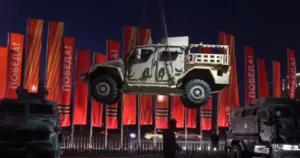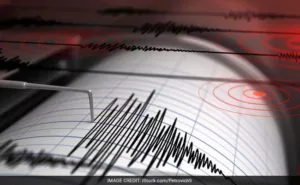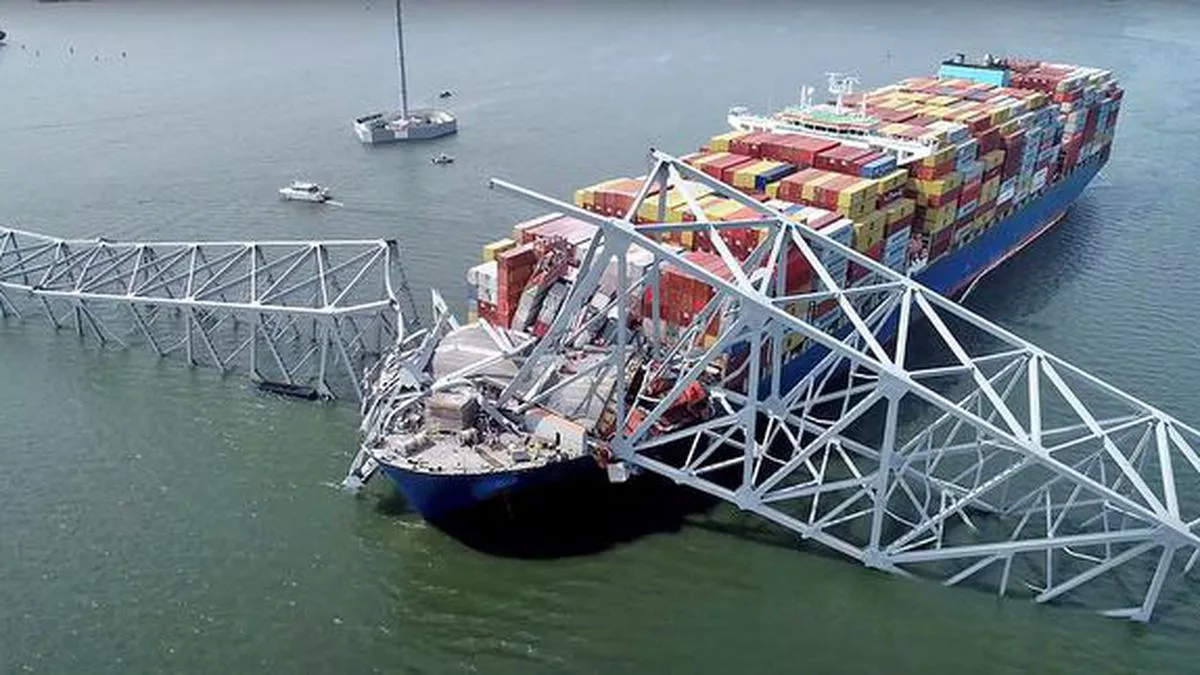A view of the vessel MV Dali under a collapsed portion of the Francis Scott Key Bridge, March 27, 2024.
| Photo Credit: AFP
The story so far: On March 26, a container vessel ran into the pillar of a bridge on the Patapsco River in Baltimore, bringing a part of the structure crashing down together with some people and cars on the bridge. By late March 27, the U.S. Coast Guard had concluded its search in the river for the bodies of the six people who fell. The vessel had an all-Indian crew.
Table of Contents
What is the timeline of events?
After departing from the port of Baltimore at 12.28 am local time, the 300-metre-long vessel Dali was headed for Colombo, Sri Lanka, with several containers of oil and some hazardous material. Less than an hour after its departure, people nearby reported the Dali’s lights flickering. Two minutes later, the ship’s course also started to angle towards two of the bridge’s pillars in the river. At 1.27 am local time, the Dali mowed into the pillar and brought down a segment of the bridge.
Shortly before the collision, a U.S. Coast Guard report said, the Dali’s crew had broadcast a mayday signal seeking help to control the vessel. This signal had alerted the Coast Guard as well as prompted local authorities to close the bridge for further traffic. A part of the bridge’s superstructure also fell on the vessel, smashing some containers and leaving them balanced precariously on the vessel.
Maryland governor Wes Moore later declared a state of emergency. The emergency response to the collision and collapse included fire service personnel, police officers, and officers of the Federal Bureau of Investigation (FBI). According to deputy FBI Director Andrew McCabe, they were present to ascertain whether the collision was accidental or deliberate. As of March 28, federal officials had virtually ruled out deliberate intent.
The Dali belongs to the Danish shipping giant Maersk, flies a Singapore flag, and is managed by the Synergy Marine Group, headed by Rajesh Unni. It had two pilots at the time of the collision.
What were the casualties?
The Synergy Marine Group said in statements that all the 22 crew members were safe, that one had suffered minor injuries, and that he had since been treated.
The bridge’s collapse dropped eight people through 15 metres into the Patapsco River, which at the time had a temperature of around 8 degrees C. While two people were fished out soon after, the Coast Guard postponed the search for six others because of the river’s depth, temperature, lack of light, the presence of sharp objects in the water, and the risk of more parts of the bridge and/or the containers falling in.
Late on March 27, the Coast Guard called the search off altogether. Read Admiral Shannon Gilreath told reporters the team no longer expected to find the six persons alive given the ambient conditions and the time lapsed since the incident.
What happened to the ship?
The Dali is propelled by a nine-cylinder two-stroke diesel engine. In the two-stroke cycle, fuel is pumped into the combustion chamber, where a spark plug causes the fuel-air mixture to explode. The energy release pushes a piston up, rotating a crankshaft attached to a propeller. The explosion’s residue (exhaust) is then pumped out of the engine to bring the piston down in the second stroke.
According to the Coast Guard, just before the collision, the Dali lost all mechanical power, electronics, and the ability to steer the ship, pointing to an engine failure. Onlookers reported the vessel’s lights coming back on shortly after, which experts have attributed to a backup generator. The Coast Guard also recorded a statement that at least one of the ship’s engines “coughed” and that “the smell of burned fuel was everywhere in the engine room”.
In 2016, the Dali had collided with and damaged a container terminal berth in Antwerp. In 2023, Chilean authorities reported issues with Dali’s propulsion system, although according to Singaporean authorities the vessel had cleared two inspections at foreign ports in June and September that year. As it got started on its preliminary investigation, the U.S. National Transportation Safety Board said it will also be checking whether the fuel used in the Dali’s engine was contaminated.
Could the collision have been prevented?
The Francis Scott Key Bridge – the structure in question – was built in the mid-1970s. Colin Caprani, a civil engineer at Monash University, Melbourne, wrote that the protective shielding around the pillars into which the ship moved weren’t designed to withstand the impact of such a large vessel. Together with the vessel’s speed at the time of collision, around 15 km/hr, he estimated the impact force to be equivalent to 20,000 tonnes.
In 2016, Panama Canal authorities upgraded its locks to allow larger ships to pass through. The Dali‘s design was subsequently modified to increase its container capacity by 10%. Before 2016, such large ships had seldom made port on the U.S. west coast, including Baltimore, for this reason – nor did bridges over waterways here have to contend with them.
According to a 2018 article from the World Association for Waterborne Transport Infrastructure, there were 35 “major bridge collapses” after a ship or barge collision between 1960 and 2015, in all killing 342 people. In the deadliest incident, a passenger vessel slammed into a bridge on the Volga river in Russia in 1983, killing 176 people, most of them on the ship. The same article said most of the bridge collapses had happened in the U.S.
Reference :
Reference link
























+ There are no comments
Add yours